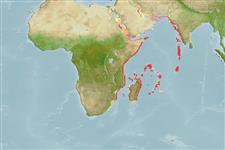Common names from other countries
>
Holocentriformes (Squirrelfishes, soldierfishes) >
Holocentridae (Squirrelfishes, soldierfishes) > Holocentrinae
Etymology: Sargocentron: Greek, sargos = sargus + Greek, kentron = sting (Ref. 45335); macrosquamis: Named for the large scales of the opercle (Ref. 27370).
Environment: milieu / climate zone / depth range / distribution range
Ökologie
seewasser riff-verbunden; tiefenbereich 4 - 22 m (Ref. 27370). Tropical
Western Indian Ocean: Red Sea to Mozambique and the oceanic islands.
Size / Gewicht / Alter
Maturity: Lm ? range ? - 4.7 cm
Max length : 9.0 cm TL Männchen/unbestimmt; (Ref. 4201)
Rückenflossenstacheln (insgesamt): 11; Rückenflossenweichstrahlen (insgesamt): 13-14; Afterflossenstacheln 4; Afterflossenweichstrahlen: 9 - 10. Body red with silvery reflections on many scales, shading to silvery white on lower part of the head, thorax, and anterior abdomen, scale edge light red; 5-6 oblique scale rows on cheek; body depth 2.3-2.7 in SL; head length (HL) 2.45-2.65 in SL; snout length 3.6-4.0 in HL; interorbital width 5.0-5.4 in HL; mouth terminal to slightly inferior; maxilla extending to a vertical at front edge of pupil or slightly before or beyond to it; upper jaw length 2.85-3.2 in HL; anterior end of nasal bone rounded; moderately large, spineless nasal fossa; upper surface of nasal bone between nasal fossa and edge of premaxillary groove with a retrorse spine; median edge of nasal bone with a retrorse spine and sometimes another anterior to it; preopercular spine 1.6-2.2 in orbit diameter, 4.75-6.4 in HL; spinules on posterior margin of preopercle 31 (on a 4.6 cm SL specimen) to 33-46 (6.25-6.85 cm); 3rd-5th dorsal spines subequal, the longest, 1.85-2.25 in HL; 3rd anal spine 1.45-1.75 in HL; broadly rounded caudal fin lobes (Ref. 27370)
Minimum depth reported taken from Ref. 30573.
Life cycle and mating behavior
Geschlechtsreife | Fortpflanzung | Ablaichen | Eier | Fecundity | Larven
Randall, J.E., 1998. Revision of the Indo-Pacific squirrelfishes (Beryciformes: Holocentridae: Holocentrinae) of the genus Sargocentron, with descriptions of four new species. Indo-Pac. Fish. (27):105 p. (Ref. 27370)
IUCN Rote Liste Status (Ref. 130435)
CITES (Ref. 128078)
Not Evaluated
Bedrohung für Menschen
Harmless
Nutzung durch Menschen
Mehr Information
ReferenzenAquakulturAquakultur ProfilZuchtlinienGenetikElectrophoresesVererbbarkeitKrankheitenVerarbeitungMass conversion
PartnerBilderStamps, Coins Misc.LauteCiguateraGeschwindigkeitSchwimmstilKiemenoberflächeOtolithsGehirngrößeSehfähigkeit
Tools
Zusatzinformationen
Download XML
Internet Quellen
Estimates based on models
Preferred temperature (Ref.
115969): 25.7 - 28.9, mean 27.5 (based on 467 cells).
Phylogenetic diversity index (Ref.
82804): PD
50 = 0.5000 [Uniqueness, from 0.5 = low to 2.0 = high].
Bayesian length-weight: a=0.01622 (0.00774 - 0.03400), b=2.97 (2.80 - 3.14), in cm Total Length, based on LWR estimates for this Genus-body shape (Ref.
93245).
Trophic level (Ref.
69278): 3.4 ±0.4 se; based on size and trophs of closest relatives
Widerstandsfähigkeit (Ref.
120179): hoch, Verdopplung der Population dauert weniger als 15 Monate. (Preliminary K or Fecundity.).
Fishing Vulnerability (Ref.
59153): Low vulnerability (10 of 100).
